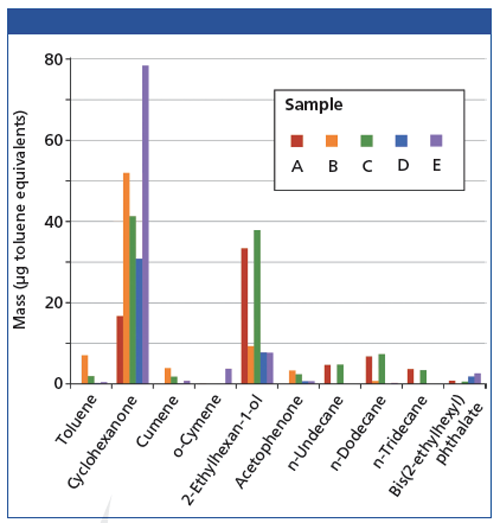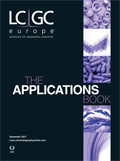Monitoring Emissions From Respiratory Medical Devices in Accordance With ISO 18562-3
The Application Notebook
This study describes the monitoring of potentially harmful volatile organic compounds (VOCs) emitted from respiratory medical devices, by pumped sampling and thermal desorption–gas chromatography–mass spectrometry (TD–GC–MS) analysis in accordance with ISO 18562 part 3. Emissions from two sets of face-mask supply tubing and three nasal cannulas were compared, and all were found to emit VOCs at levels that may give cause for concern.
David Barden and Gareth Roberts, Markes International
This study describes the monitoring of potentially harmful volatile organic compounds (VOCs) emitted from respiratory medical devices, by pumped sampling and thermal desorption–gas chromatography–mass spectrometry (TD–GC–MS) analysis in accordance with ISO 18562 part 3. Emissions from two sets of face-mask supply tubing and three nasal cannulas were compared, and all were found to emit VOCs at levels that may give cause for concern.
Respiratory medical devices (RMDs) are widely used in medical practice, but the potential for polymeric components in the gas pathways to release harmful volatile organic compounds (VOCs) is giving rise to concern that prolonged use could be detrimental to patient health. This is the driving force behind ISO 18562 (1), which was released in March 2017. The predecessor to ISO 18562 (ISO 10993) did not cover VOC emissions directly, and was partly based on animal implant tests of uncertain scientific value. In contrast, the new method is based on tests performed directly on the device, and does not involve animal experimentation.
The ultimate outcome of testing in accordance with ISO 18562 is to assess the patient’s exposure to chemicals from the RMD during their treatment (expressed in units of µg/day), which is then related to thresholds of toxicological concern (TTCs) specified in ISO 18562. Devices requiring testing under ISO 18562 include medical devices and accessories containing gas pathways, which includes ventilators, anaesthesia workstations, oxygen-conserving equipment, nebulizers, gas monitors, masks, mouthpieces, breathing tubes, and breathing accessories.
Part 3 of ISO 18562 deals with testing for emissions of VOCs, and references two analytical options: ISO 16000-6 for sorbentâtube sampling and ASTM D5466 for canister sampling. Both are wellâestablished and popular for air monitoring and related applications, but generally speaking, tube-based methods such as ISO 16000-6 are preferred for investigating emissions from products and materials, for reasons of wider analyte range and also greater ease of use. Analysis in accordance with the tube-based standard ISO 16000-6 is therefore the focus of this study.
Experimental
Three sets of face-mask supply tubing (A, B, C), and two nasal cannulas (D, E) were assessed. In brief, VOC emissions were collected on a 3½″ × ¼″ sorbent tube after being swept from the RMD by a flow of clean air, followed by analysis of the tubes using a TD100âxr™ thermal desorption tube autosampler connected to a GC–MS system. Compounds were identified by screening the chromatograms against a 540-component library of compounds typically encountered in polymeric consumer goods and construction materials. Full analytical conditions are available in Markes International’s Application Note 132 (http://chem.markes.com/RMD).
Results and Discussion
VOC Profiles: As an example of a typical profile, Figure 1 shows the analysis of Sample A (face-mask supply tubing). The large number of compounds released is immediately apparent, as is the presence of a broad hydrocarbon/oil-like response, which was confirmed as a real feature by its absence from a sampling run without the RMD in position.
Figure 1: VOC profile of a sample of face-mask supply tubing. Selected peaks are labelled.

Across the five samples A–E, screening of the chromatographic profiles indicated the presence of between 45 and 60 components from the 540-component library. The most abundant components are shown in Figure 2.
Figure 2: Comparison of the masses of the 10 compounds present at levels above 2000 ng in any of the samples.

Two compounds dominate the profiles of all five samples: Cyclohexanone is used as a binding agent for polymer fittings, while 2-ethylhexan-1-ol is a precursor in the synthesis of phthalate plasticizers. The large number of other compounds present includes solvents, such as dichloromethane (now declining in use as a binding agent, but present in all five samples), methyl ethyl ketone (sometimes used in conjunction with cyclohexanone, and found in Samples B and D), and toluene (present in all five samples).
Phthalates were also present in all five samples, with diethyl phthalate and bis(2-ethylhexyl) phthalate being confidently identified. The latter was the least volatile of the components, eluting as the last peak. A specification for phthalate-free medical tubing is available, but these results show that at least some manufacturers are not yet producing phthalate-free products.
TVOC Values and Exposures: ISO 18562-3 is primarily concerned with the “dose to the patient of a substance or sum of substances” within three exposure categories, which are: “Limited” (≤24 h), “Prolonged”(>24 h and <30 days), and “Permanent” (≥30 days). The sampling time of 1 h and sampling rate of 0.1 L/min used in the current study means that the results are of greatest relevance to breathing volumes of newborns and to devices used in the “Limited” category.
To assess how Samples A–E perform within this category, total VOC (TVOC) values were determined by integrating the entire chromatogram (Table 1). Extrapolating these 1-h TVOC values to 24 h on the basis of a separately determined decay curve allowed derivation of cumulative exposure values for the first 24 h of use. Values are in the range
1370–7000 µg, which exceeds three times the TTC for adults of 360 µg/day, and is over 500 times the TTC for newborns of ~2.5 µg/day.

Conclusions
This study shows that the sorbent sampling tubes and TD–GC–MS analytical equipment used is versatile and fully compliant with the requirements of ISO 18562-3 (and of the cited method ISO 16000â6). In particular, the thermal desorption instrument used to preâconcentrate the vapours is highly sensitive and easily automated, and in combination with GC–MS is able to reliably identify compounds released from the gas pathways of respiratory medical devices.
The results obtained indicate that some respiratory medical devices emit a broad range of VOCs, at levels that indicate potential issues with manufacturing quality. The use of low flow rates, and the fact that the products were sampled immediately after being removed from the packaging, means that these results represent a “worstâcase scenario” for VOC emissions, but nevertheless one that may be typical of products used for the care of certain patients.
References
ISO 18562: Biocompatibility evaluation of breathing gas pathways in healthcare applications, International Organization for Standardization, 2017. Part 3 (“Tests for emissions of volatile organic compounds (VOCs)”) is available at www.iso.org/standard/62894.html.
For the complete study, including a full table of results, download Markes International’s Application Note 132 (http://chem.markes.com/RMD).

Markes International
Gwaun Elai Medi-Science Campus, Llantrisant, Wales, UK
Tel.: +44 (0)1443 230935
E-mail: enquiries@markes.com Website: www.markes.com


.png&w=3840&q=75)

.png&w=3840&q=75)



.png&w=3840&q=75)



.png&w=3840&q=75)





